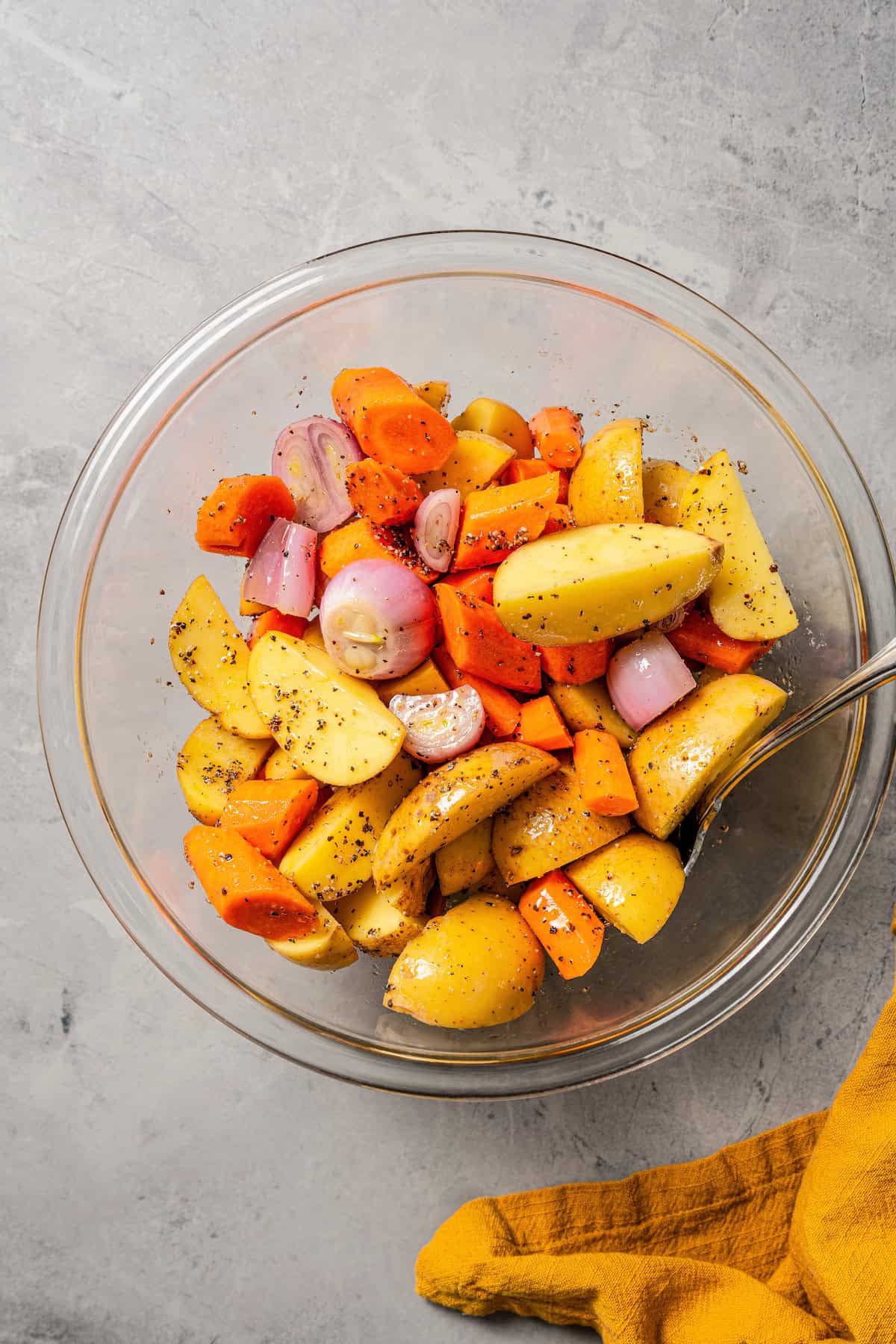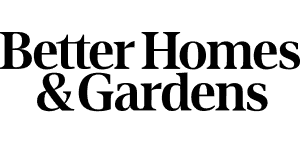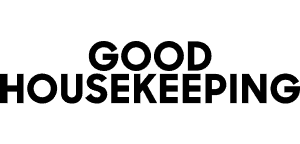This post may contain affiliate links. Please read our disclosure policy.
This pork roast recipe is a whole meal in one! Juicy pork shoulder is seasoned with fresh citrus and herbs and slow-roasted in the same pan with carrots, potatoes, and onions. You won’t believe how juicy it turns out.

When I’m not making a Guinness beef stew or cozy pot roast on the weekend, you can bet this easy pork roast is in the oven. It’s one of my favorite Sunday roast recipes! Juicy boneless pork shoulder is seared and then slow-roasted in citrusy cooking juices alongside tender vegetables and herbs. After a while, the meat gets so tender that it cuts like butter, and the roasted veggies soak up all the flavor in the pan. It’s an all-in-one meal that leaves most of the work to my oven!
Why You’ll Love This Easy Pork Roast Recipe
- Low and slow. I cook this boneless pork roast the old-fashioned way: long and low in the oven so that the inside becomes meltingly tender while the outside crisps up in the heat. When all’s said and done, the pork is super juicy, and the veggies get perfectly roasted.
- Dinner made easy. I love recipes like my slow cooker pot roast, honey garlic roast pork tenderloin, and this easy pork roast, where the meat and a side of vegetables are cooked all at the same time.
- Great for leftovers. This pork roast recipe makes enough to feed a small army, so we always have leftovers. Luckily, it’s easy to freeze or keep in the fridge for tasty lunches and meals later on. Roast pork sandwiches with rhubarb chutney, anyone?
Is pork shoulder the same as pork butt?
Pork butt and pork shoulder both come from the shoulder area of the pig, but pork butt, also known as Boston butt, is cut from the upper part, while pork shoulder comes from the lower section. Since they’re both tougher and on the fat side, they’re ideal for slow cooking methods like roasting, braising, or stewing.

Ingredients You’ll Need
It doesn’t take much to turn a humble pork shoulder into a succulent, juicy pork roast dinner. But, there are a few key ingredients, which I’ll cover below. Scroll to the recipe card after the post for a printable list with the full amounts.
- Pork Shoulder – I use boneless pork shoulder. This cut of pork is great for slow roasting in the oven.
- Olive Oil – Rubbing the pork with a good-quality cooking oil, like olive oil, helps the outside brown up nicely in the heat.
- Seasonings – I use garlic powder, salt, and black pepper. If you’d like to sweeten it, add a tablespoon or two of brown sugar to the dry rub.
- Apple Juice – Apples and pork are a match made in culinary heaven. You can use regular apple juice, or I sometimes take inspiration from my apple cider-braised pork shoulder and use fresh apple cider when it’s in season.
- White Wine – I like Chardonnay or Pinot Grigio, but any dry white wine works. You can also use sherry or replace the wine with chicken broth if you’d rather cook without alcohol.
- Fresh Orange – Juice ½ of an orange.
- Herbs – Fresh rosemary and thyme sprigs.
- Roasting Vegetables – My favorites for this pork roast recipe are chopped shallots, carrots, and Yukon gold potatoes. You can use any vegetables with similar roasting times. Other good options are butternut squash, acorn squash, and beets. Fresh garlic cloves work perfectly, too.
Should I Use Bone-In or Boneless Pork?
I use a boneless pork shoulder, but you can make a bone-in pork shoulder roast if you prefer. Everything else in the recipe stays the same; just remember that bone-in pork takes longer to cook. Budget your roasting times accordingly, and only add the vegetables in the last 1-2 hours of cooking.
How to Cook a Pork Roast in the Oven
Slow roasting is the best way to bring out the juiciness and flavor in a hefty pork shoulder. Save the quick cooking for pork steaks. Here’s how to get this pork roast with vegetables seasoned and in the oven in just a few easy steps:




- Prepare the pork. First, rub the pork shoulder all over with olive oil and season with garlic powder, salt, and pepper. Before you get it into the oven, quickly brown the pork in a skillet.
- Assemble. Nestle your seared pork shoulder into a roasting pan or a large Dutch oven – you don’t need to use a roasting rack – and pour over the wine and apple juice. Squeeze orange juice over the top and add the fresh herbs.
- Roast. Roast the pork in a 350ºF oven under aluminum foil. Around the 2-hour mark, add your veggies to the bottom of the pan and around the meat. Cover the roast again, and return it to the oven for another 1 ½-2 hours.
- Rest. Once your pork roast is out of the oven, you’ll want to let it rest for 15 minutes or so before you slice it. Don’t skip this step! Just like cooking chicken or steak, resting lets all the juices redistribute throughout the meat for extra succulent slices.
- Serve. Serve the pork with a side of roasted veggies drizzled with pan juices. See below for more ideas!
Crispy Pork Skin
As a final step before removing the pork roast from the oven, I like to remove the foil, switch on the broiler, and let the pork sizzle under the heat for a couple of minutes. The hot oven will crisp up the pork rind and give the top a nice crust and a deep golden brown, like a porchetta recipe. This is optional but very recommended!

How Long Should a Pork Roast Be Cooked?
The exact roasting times will vary depending on the size of your pork roast. For this recipe, I use a 4-pound boneless pork shoulder, and the total roasting time comes to about 3 ½ to 4 hours at 350ºF. You may need to adjust the cooking time if you’re using a smaller pork shoulder.
The easiest way to tell if your pork is cooked is to check it using an instant-read thermometer. Pork roast is done when the internal temperature registers at 145ºF on a meat thermometer.
More Tips for Perfect Roast Pork
- Pat the pork dry. Use paper towels to pat dry the pork before you add the seasoning rub. It helps the spices stick better.
- Don’t skip the sear. Giving the pork shoulder a hot, quick sear in a skillet before roasting locks in all the flavors and helps the outside roast up nice and brown.
- Roast under foil. Cook the boneless pork roast under foil right up until you’re ready to broil the top. This keeps the meat from drying out in the low and slow heat.
- Remember to baste. I like to baste the pork with some of the juices at the halfway mark when I add the vegetables to the pan. A little flavor boost never hurts!
- Let it rest. Always allow the meat to rest after cooking and before slicing so the juices can redistribute evenly, making your pork as juicy as possible.
- Use your favorite herbs and spices. The best way to mix up this pork roast recipe is by playing around with different seasonings. Some tasty options I’ve tried are my homemade seasoning from my pork medallions recipe. Still, you could also try onion powder, dried herbs like dried oregano or dried thyme, ground mustard, paprika, etc. You can also mix a tablespoon of soy sauce with the fresh orange juice, or add a splash of liquid smoke and a sprinkle of Hawaiian sea salt for a Kalua pork vibe.
Serving Suggestions
This really good pork roast with vegetables is a meal-in-one, perfect for cozy Sundays at home! I love to let the pork roast slowly all day, then serve it with the carrots and potatoes smothered in pan drippings, begging to be sopped up with butter swim biscuits. If I feel like something extra, I’ll make a pan of buttery apple stuffing and a crunchy kale salad to serve on the side. And I’ll never say no to a sneaky basket of homemade orange-glazed dinner rolls or cheddar bay biscuits!

Storing and Reheating Leftover Roast
- Refrigerate. Store the pork roast and vegetables together or separately in an airtight container in the fridge for up to 3-4 days.
- Reheat. We like to use roast pork leftovers in sandwiches and wraps in the following days. Otherwise, the pork and veggies can be quickly reheated in the microwave, or you can warm everything in the oven under foil until hot throughout.
- Freeze. Leftover pork can be frozen for up to 3 months. I don’t recommend freezing the veggies, though. Defrost the pork roast in the fridge before reheating and serving.
Pin this now to find it later
Pin It
Pork Roast
Ingredients
- 4 pounds boneless pork shoulder
- 4 tablespoons olive oil, divided
- 2 teaspoons garlic powder
- 4 teaspoons salt, divided
- 3 teaspoons freshly ground black pepper, divided
- ¾ cup apple juice
- ¾ cup white wine
- ½ orange, juice of
- 2 springs fresh rosemary
- 3 sprigs fresh thyme
- 4 shallots, peeled and cut into 1-inch chunks
- 4 medium carrots, cut into 1-inch chunks
- 1 pound Yukon gold potatoes, cut into wedges
Instructions
- Prep. Preheat the oven to 350°F.
- Season the pork. Pat the pork dry with paper towels and rub all over with 2 tablespoons of olive oil, garlic powder, 3 teaspoons of salt, and 1 ½ teaspoons of black pepper.
- Sear. Heat 1 tablespoon olive oil over medium-high heat in a large heavy-bottomed skillet. Sear the pork on all sides until golden brown.
- Assemble. Place the seared pork in a roasting pan and pour the apple juice, white wine, and orange juice over the top. Scatter the rosemary and thyme around the pork.
- Roast. Cover the roasting pan tightly with aluminum foil and roast for 2 hours.
- Add the veggies. In a mixing bowl, toss the shallots, carrots, and potatoes with the remaining olive oil, salt, and pepper. Uncover the roasting pan. Spoon the juices in the pan over the meat and then scatter the veggies around the pork.
- Continue roasting. Cover the roasting pan again and roast for an additional 1 ½-2 hours or until the pork reaches an internal temperature of 145°F and the veggies are cooked through.
- Broil (optional). If you would like your pork to have an extra crispy exterior, turn off the oven and turn on the broiler. Broil the pork for a couple of minutes to reach your desired shade of golden brown.
- Rest. Remove the pork roast from the oven and let it rest for 15 minutes before slicing.
- Serve. Slice the pork and serve it with the roasted veggies. You can spoon the juices from the roasting pan over the meat if you’d like.
Nutrition
Nutritional info is an estimate and provided as courtesy. Values may vary according to the ingredients and tools used. Please use your preferred nutritional calculator for more detailed info.









We love this recipe and have shared it with many of our friends and family!
Quick question though, would this come out just as well in a slow cooker?
YAY I’m so glad you love it! 😊 You can definitely cook it in the slow cooker for about 8 to 10 hours on Low. I suggest searing the pork until browned on all sides before popping it in the slow cooker, layered right over all the veggies. Pour the liquids and then just let it cook.
I love the ingredients and I’m planning on making this for my niece who is expecting her 3rd child in October. She has 2 little boys 5&3 the 5 year old has Down’s syndrome so she has her hands full! Does this freeze well? I’d like to help her with some meals!
Aww how nice! This is such a thoughtful idea for your niece, she’s going to appreciate it so much! 💛
Yes, it does freeze really well! For best quality, you can freeze the pork roast for 2–3 months. Just cool the cooked pork, then store it in airtight, freezer-safe containers or bags to avoid freezer burn. When ready to use it, thaw it overnight in the fridge and then reheat the pork to 165°F. I don’t usually recommend freezing the veggies — you can, but they tend to get mushy once thawed.
This was excellent. Prepared according to the recipe and it worked great.
Hi!
Very happy you enjoyed it! Thank you for sharing. ☺️
I made this today and it turned out perfectly. This is my new favorite pork roast recipe. Thanks for sharing!
Yay! I’m so happy to hear it turned out perfectly for you. It’s my favorite way to cook a pork roast, too—so cozy and delicious! 😊